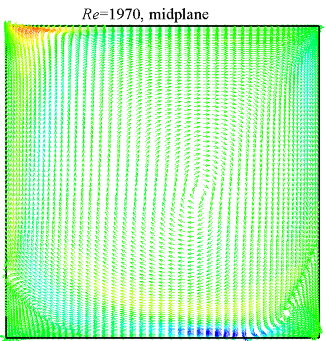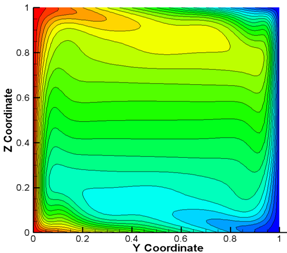· Developing algorithms for parallel scientific computing.
My primary area of interest is developing highly
scalable numerical algorithms and parallel software for simulations of various
nontrivial hydrodynamic phenomena in fluid mechanics. I utilize an open source
numerical package MUMPS
(Multi Frontal Massively Parallel sparse direct Solver) to develop Full
Pressure Coupled Direct (FPCD) time marching algorithm for time integration of
incompressible Navier Stokes equations. Along with this I developed my own PAR-ASA-CLGS code based on the iterative multigrid approach. The both
solvers utilize the fully pressure-velocity coupled approach for incompressible
flows. PAR-ASA-CLGS has been successfully tested on HLRN II massively
parallel supercomputer in solving Navier-Stokes equations with over 32 Million
degrees of freedom on 2048 cores. The algorithm achieved N/log(N) and N/ln(N)
in a strong scalability test for single- and multigrid configurations
respectively reaching the theoretical asymptotic limit.
The developed multigrid algorithm has been successfully applied to a
stability analysis of the flow inside three dimensional lid-driven and
differentially heated cavities, determining the main characteristics of the
instability onset mechanism when going from steady to periodic flow.
|
|
|
·
Numerical Benchmarking
We propose a new benchmark case of a fully three-dimensionally
flow in a cubic cavity driven by the lid moving at 45º relatively to its
lateral boundaries. This flow has no any
two-dimensional similarities, and the velocity components are equally large in
x- and z- directions. The flow exhibits interesting and not yet studied
three-dimensional flow patterns, as is shown in the figure below for Re=103.

·
Adapting of the developed
algorithms to the linear stability analysis.
Figure 3.1.
Perturbation of vx
The
work has been performed in collaboration with Laurette Tuckerman (PMMH-ESPCI).
We investigate a potential of utilizing of the developed time marching
numerical algorithms for the linear stability analysis. The FPCD approach
utilizing the LU decomposition of the Stokes operator, shows competitive
computational times and was successfully applied to the linear stability
analysis for two-dimensional problems. In the following picture we show a distribution of the absolute values of the most unstable
eigenmode of the main flow characteristics , for two dimensional lid-driven
cavity, obtained on 200 ª 200 grid for
Re=8700




However the FPCD approach
remains restricted by available computer memory when is applied to
three-dimensional models. Assuming that this restriction will be removed in near
future this approach should not be immediately neglected.
·
Applied engineering
analysis using commercial Fluent -Ansys Software
We
performed a full scale CFD elliptic analysis of anisotropic flow in the wake of
a wind turbine. Special techniques of grid refine

The
proposed model implementation requires no extra features other than those
available in a commercial code, and may be a powerful instrument for wind
turbine engineers. The whole study
report is located here.

